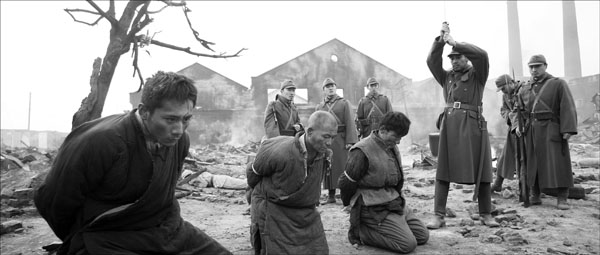|
Reviews of Recent Independent, Foreign, & Documentary Films in Theaters and DVD/Home Video

CITY OF
LIFE AND DEATH The assault of the Japanese Imperial Army on China’s ancient capital in 1937 is so notorious that it has come down through history as “The Rape of Nanking.” Two Japanese generals were executed as war criminals for the actions under their commands. City of Life and Death is the first feature on the horrors from the Chinese point of view as well as a government-approved commemoration of the 60th anniversary of Communist rule. So it is that much more impressive that writer/director Lu Chuan has made a humanistic epic. The film opens with the ominous descriptions of the start of the December siege covered in two other recent films, the American documentary Nanking (2007) by Bill Guttentag and Dan Sturman and German director Florian Gallenberger’s feature John Rabe (2009), based on the same eyewitness notes by resident Europeans. Then we’re immediately thrust into the Chinese perspective in widescreen black and white, shot by cinematographer Cao Yu with contemporary hand-held urgency, recalling another reexamination of Japanese occupation in Clint Eastwood’s Letters from Iwo Jima (2006). Amidst the overwhelming attack on the city’s old defensive walls, a boy is seen standing tall with a couple of patriotic soldiers in a bit of a dig at the undisciplined panic of Chiang Kai-shek’s army’s attempt to flee the city and abandon the civilians. Yet even that criticism pales as the Japanese ruthlessly and systematically round up every Chinese soldier as a POW and then methodically kill them all in brutal mass executions by gun, bayonet, fire, drowning, and even live burial. There is no cut away to division headquarters for the context of tactical and strategic explanations (if such slaughter had a military rationale), but not all the Japanese are robo-drones or some special unit of sociopaths. Against the escalating atmosphere of a world gone mad, the sympathetic portrayal of a couple of Japanese is particularly striking—and the source of controversy for some audience members in China. A young soldier, Kadokawa (Hideo Nakaizumi), is far less enthusiastic than his friend the commander. Further, the Japanese army’s notorious system of drafting locals into service as “comfort women” is depicted as an extension of their crude brothels that employed and used up Japanese prostitutes, like Yuriko (Yuko Miyamoto), who the naïve Kadokawa falls in love with. But it is ordinary soldiers who are looting and committing atrocities as they get swept up in the weeks of untrammeled violence, where hunting down every possible Chinese soldier becomes a mania. That hysteria brings the Japanese into the self-designated International Safety Zone created mostly by Europeans, including Nazi representative John Rabe (John Paisley), who took in and managed to protect thousands of refugees as well as secretly trying to treat wounded Chinese soldiers. The organizing committee includes heroic Chinese more prominently here than in the other versions, including Rabe’s male secretary. Even as the desperate Zone administrators try to disguise their female charges as boys to shield them from the rampaging epidemic of rapes, they are forced to ask for sacrificial volunteers to service the army (though the number shown here is higher than in the other tellings). The
director’s extensive research found more witnesses on both sides than
others have recorded, which could account for even more cruel situations
than are in other written and filmed descriptions. (The long term fates
of characters based on real people are cited at the credits). There are
also a couple of brief editing jags from reported censorship of both the
most benevolent and atrocious Japanese actions. The concluding Japanese victory
parade is a scarily impressive sight, with flags, huge drums, chanting,
and aggressive dances. However, this display of primitive pride rolling
through the ruined city seems like a tacked-on message of the perils of
ultra-nationalism to finally convince the sensitive young Japanese
soldier that he cannot fit in such a society.
Nora Lee Mandel
|

